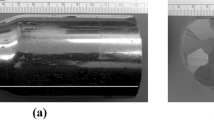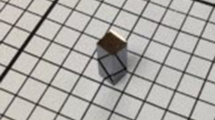Abstract
The quest for cost-effective, high performing room temperature semiconductor detector (RTSD) materials for high-energy gamma rays has been continuing for more than three decades. The requirements for RTSD materials, however, are more stringent as compared to other applications unrelated to detection of X- and gamma rays, mainly due to the requirement of thick detectors for sufficient absorption of high-energy electromagnetic radiation. The II–VI compound CdZnTe (CZT) with the composition of 10 atomic % of Zn (Cd0.9Zn0.1Te) has been the material of choice over the past several years, and it has dominated the market for RTSD materials. Despite its commercial success as a room-temperature radiation detection material, CZT suffers from a lack of compositional homogeneity on both a micro- and macro-scale and the presence of high concentrations of sub-grain boundary (dislocation walls) networks and secondary phases (Te-rich inclusions). This chapter focuses on the presence of performance-limiting defects in CZT that hinder the yield and elevate the cost of high-quality detectors. The presence of such performance-limiting defects has restricted widespread deployment of CZT for a variety of potential applications, particularly for uses of relatively large detectors where the demands on material perfection are significantly greater. In the recent past, replacing some of the tellurium with selenium in the CZT matrix was found to be very effective in a drastic reduction of Te-rich secondary phases and dislocation networks, plus allowing for better compositional homogeneity. The reduced concentrations of these intrinsic defects in the quaternary compound Cd1−xZnxTe1−ySey (CZTS) ensure improved spatial homogeneity of the charge-transport characteristics, which in turn enhances the detector performance and yield. This chapter will provide an overview of recent developments to optimize the composition and charge transport of the quaternary CdZnTeSe material as a potential next-generation detector material operable at room temperature.
Access this chapter
Tax calculation will be finalised at checkout
Purchases are for personal use only
Similar content being viewed by others
References
Schlesinger, T. E., et al. (2001). Cadmium zinc telluride and its use as a nuclear radiation detector material. Materials Science and Engineering R, 32, 103.
Yang, G., & James, R. B. (2009). Applications of CdTe, CdZnTe, and CdMnTe radiation detectors. In Physics, defects, hetero- and nano-structures, crystal growth, surfaces and applications part II, (EDAX, Triboulet R. et al.) (p. 214). Elsevier.
Harrison, F. A., et al. (2013). The nuclear spectroscopic telescope array (NuSTAR) high-energy X-ray mission. The Astrophysical Journal, 770, 103.
Krawczynski, H. S., et al. (2016). X-ray polarimetry with the polarization spectroscopic telescope array (PolSTAR). Astroparticle Physics, 75, 8.
Slomka, P. J., et al. (2019). Solid-state detector SPECT myocardial perfusion imaging. Journal of Nuclear Medicine, 60, 1194.
Triboulet, R. (2005). Fundamentals of the CdTe and CdZnTe bulk growth. Physica Status Solidi (c), 5, 1556.
Rudolph, P. (1994). Fundamental studies on Bridgman growth of CdTe. Progress in Crystal Growth and Characterization of Materials, 29, 275.
**g, W., & Chi, L. (2019). Recent advances in cardiac SPECT instrumentation and imaging methods. Physics in Medicine and Biology, 64, 06TR01.
Sakamoto, T., et al. (2011). The second swift burst alert telescope gamma-ray burst catalog. The Astrophysical Journal Supplement Series, 195, 1.
Takahashi, T., et al. (2001). High-resolution CdTe detector and applications to imaging devices. IEEE Transactions on Nuclear Science, 48, 287.
MacKenzie, J., et al. (2013). Advancements in THM-grown CdZnTe for use as substrates for HgCdTe. Journal of Electronic Materials, 42, 3129.
Iniewski, K. (2014). CZT detector technology for medical imaging. Journal of Instrumentation, 9, 1.
Kargar, A., et al. (2011). Charge collection efficiency characterization of a HgI2 Frisch collar spectrometer with collimated high energy gamma rays. Nuclear Instruments and Methods in Physics Research A, 652, 186.
Hitomi, K., et al. (2013). TlBr capacitive Frisch grid detectors. IEEE Transactions on Nuclear Science, 60, 1156.
He, Y., et al. (2018). High spectral resolution of gamma-rays at room temperature by perovskite CsPbBr3 single crystals. Nature Communications, 9, 1609.
Johns, P. M., & Nino, J. C. (2019). Room temperature semiconductor detectors for nuclear security. Journal of Applied Physics, 126, 040902.
Takahashi, T., & Watanabe, S. (2001). Recent progress in CdTe and CdZnTe detectors. IEEE Transactions on Nuclear Science, 48, 950.
Szeles, C., & Eissler, E. E. (1998). Current issues of high-pressure Bridgman growth of semi-insulating CdZnTe. Materials Research Society Symposium Proceedings, 484, 309.
Szeles, C., et al. (2004). Development of the high-pressure electro-dynamic gradient crystal-growth technology for semi-insulating CdZnTe growth for radiation detector applications. Journal of Electronic Materials, 33, 742.
Triboulet, R., et al. (1990). “Cold travelling heater method”, a novel technique of synthesis, purification and growth of CdTe and ZnTe. Journal of Crystal Growth, 101, 216.
El Morki, A., et al. (1994). Growth of large, high purity, low cost, uniform CdZnTe crystals by the “cold travelling heater method”. Journal of Crystal Growth, 138, 168.
Shiraki, H., et al. (2009). THM growth and characterization of 100 mm diameter CdTe single crystals. IEEE Transactions on Nuclear Science, 56, 1717.
Zhang, N., et al. (2011). Anomalous segregation during electrodynamic gradient freeze growth of cadmium zinc telluride. Journal of Crystal Growth, 325, 10.
Perfeniuk, C., et al. (1992). Measured critical resolved shear stress and calculated temperature and stress fields during growth of CdZnTe. Journal of Crystal Growth, 119, 261.
Datta, A., et al. (2011). Experimental studies on control of growth interface in MVB grown CdZnTe and its consequences. In IEEE Nuclear Science Symposium Conference Record 4720. IEEE.
Zhou, B., et al. (2018). Modification of growth interface of CdZnTe crystals in THM process by ACRT. Journal of Crystal Growth, 483, 281.
Roy, U. N., et al. (2010). Growth and interface study of 2 in diameter CdZnTe by THM technique. Journal of Crystal Growth, 312, 2840.
Gul, R., et al. (2017). A comparison of point defects in Cd1−xZnxTe1−ySey crystals grown by Bridgman and traveling heater methods. Journal of Applied Physics, 121, 125705.
Carini, G. A., et al. (2007). High-resolution X-ray map** of CdZnTe detectors. Nuclear Instruments and Methods in Physics Research Section A: Accelerators, Spectrometers, Detectors and Associated Equipment, 579, 120.
Bolotnikov, A. E., et al. (2013). Characterization and evaluation of extended defects in CZT crystals for gamma-ray detectors. Journal of Crystal Growth, 379, 46.
Yang, G., et al. (2013). Post-growth thermal annealing study of CdZnTe for develo** room-temperature X-ray and gamma-ray detectors. Journal of Crystal Growth, 379, 16.
Bolotnikov, A. E., et al. (2016). CdZnTe position-sensitive drift detectors with thicknesses up to 5 cm. Applied Physics Letters, 108, 093504.
Szeles, C., et al. (2002). Advances in the crystal growth of semi-insulating CdZnTe for radiation detector applications. IEEE Transactions on Nuclear Science, 49, 2535.
Triboulet, R. (2003). Crystal growth technology. In H. J. Scheel & T. Fukuda (Eds.), CdTe and CdZnTe growth (p. 373). Wiley.
Guergouri, K., et al. (1988). Solution hardening and dislocation density reduction in CdTe crystals by Zn addition. Journal of Crystal Growth, 86, 61.
Imhoff, D., et al. (1991). Zn influence on the plasticity of Cd0.96Zn0.04Te. Journal de Physique III France, 1, 1841.
Buis, C., et al. (2013). Effects of dislocation walls on image quality when using cadmium telluride X-ray detectors. IEEE Transactions on Nuclear Science, 60, 199.
Johnson, C. J. (1989). Recent Progress in lattice matched substrates for HgCdTe epitaxy. SPIE, 1106, 56.
Tanaka, A., et al. (1989). Zinc and selenium co-doped CdTe substrates lattice matched to HgCdTe. Journal of Crystal Growth, 94, 166.
Fiederle, M., et al. (1994). Comparison of CdTe, Cd0.9Zn0.1Te and CdTe0.9Se0.1 crystals: Application for γ- and X-ray detectors. Journal of Crystal Growth, 138, 529.
Roy, U. N., et al. (2014). Growth of CdTexSe1−x from a Te-rich solution for applications in radiation detection. Journal of Crystal Growth, 386, 43.
Roy, U. N., et al. (2015). High compositional homogeneity of CdTexSe1−x crystals grown by the Bridgman method. Applied Physics Letters Materials, 3, 026102.
Roy, U. N., et al. (2014). Evaluation of CdTexSe1−x crystals grown from a Te-rich solution. Journal of Crystal Growth, 389, 99.
Hannachi, L., & Bouarissa, N. (2008). Electronic structure and optical properties of CdSexTe1−x mixed crystals. Superlattices and Microstructures, 44, 794.
Roy, U. N., et al. (2019). Role of selenium addition to CdZnTe matrix for room-temperature radiation detector applications. Scientific Reports, 9, 1620.
Roy, U. N., et al. (2020). X-ray topographic study of Bridgman-grown CdZnTeSe. Journal of Crystal Growth, 546, 125753.
Egarievwe, S. U., et al. (2020). Optimizing CdZnTeSe Frisch-grid nuclear detector for gamma-ray spectroscopy. IEEE Access, 8, 137530.
Hwang, S., et al. (2019). Anomalous Te inclusion size and distribution in CdZnTeSe. IEEE Transactions on Nuclear Science, 66, 2329.
Roy, U. N., et al. (2019). High-resolution virtual Frisch grid gamma-ray detectors based on as-grown CdZnTeSe with reduced defects. Applied Physics Letters, 114, 232107.
Klep**er, J. W., et al. (2021). Growth of Cd0.9Zn0.1Te1−ySey single crystals for room-temperature gamma ray detection. IEEE Transactions on Nuclear Science, 68, 2429.
Roy, U. N., et al. (2019). Evaluation of CdZnTeSe as a high-quality gamma-ray spectroscopic material with better compositional homogeneity and reduced defects. Scientific Reports, 9, 7303.
Nag, R., et al. (2021). Characterization of vertical Bridgman grown Cd0.9Zn0.1Te0.97Se0.03 single crystal for room-temperature radiation detection. Journal of Materials Science: Materials in Electronics, 32, 26740.
Herraiz, L. M., et al. (2021). Vertical gradient freeze growth of two inches Cd1−xZnxTe1−ySey ingots with different Se content. Journal of Crystal Growth, 537, 126291.
Franc, J., et al. (2020). Microhardness study of Cd1-x ZnxTe1-ySey crystals for X-ray and gamma ray detectors. Materials Today Communications, 24, 101014.
Chang, C. Y., & Tseng, B. H. (1997). Crystal growth of CdTe alloyed with Zn, Se and S. Materials Science and Engineering: B, 49(1), 1.
Gul, R., et al. (2015). Research update: Point defects in CdTexSe1−x crystals grown from a Te-rich solution for applications in detecting radiation. Applied Physics Letters Materials, 3, 040702.
Yakimov, A., et al. (2019). Growth and characterization of detector-grade CdZnTeSe by horizontal Bridgman technique. SPIE Proceedings, 11114, 111141N.
Chaudhuri, S. K., et al. (2020). Pulse-shape analysis in Cd0.9Zn0.1Te0.98Se0.02 room-temperature radiation detectors. Applied Physics Letters, 116, 162107.
Chaudhuri, S. K., et al. (2020). Charge transport properties in CdZnTeSe semiconductor room-temperature γ-ray detectors. Journal of Applied Physics, 127, 245706.
Dědič, V., et al. (2021). Map** of inhomogeneous quasi-3D electrostatic field in electro-optic materials. Scientific Reports, 11, 2154.
Pipek, J., et al. (2021). Charge transport and space-charge formation in Cd1−xZnxTe1−ySey radiation detectors. Physical Review Applied, 15, 054058.
Park, B., et al. (2022). Bandgap engineering of Cd1− xZnxTe1− ySey (0< x< 0.27, 0< y< 0.026). Nuclear Instruments and Methods in Physics Research Section A: Accelerators, Spectrometers, Detectors and Associated Equipment, 1036, 166836.
Chaudhuri, S. K., et al. (2021). Quaternary Semiconductor Cd1− xZnxTe1− ySey for High-Resolution, Room-Temperature Gamma-Ray Detection. Crystals, 11, 7.
Franc, J., et al. (2021). Spectral Dependence of the Photoplastic Effect in CdZnTe and CdZnTeSe. Materials, 14, 1465.
Egarievwe, S. U., et al. (2019). Ammonium fluoride passivation of CdZnTeSe sensors for applications in nuclear detection and medical imaging. Sensors, 19, 3217.
Rejhon, M., et al. (2018). Influence of deep levels on the electrical transport properties of CdZnTeSe detectors. Journal of Applied Physics, 124, 235702.
Guskov, V. N., et al. (2004). Vapour pressure investigation of CdZnTe. Journal of Alloys and Compounds, 371, 118.
Brill, G., et al. (2005). Molecular beam epitaxial growth and characterization of Cd-based II-VI wide-bandgap compounds on Si substrates. Journal of Electronic Materials, 34, 655.
Roy, U. N., et al. (2021). Optimization of selenium in CdZnTeSe quaternary compound for radiation detector applications. Applied Physics Letters, 118, 152101.
Roy, U. N., et al. (2019). Characterization of large-volume Frisch grid detector fabricated from as-grown CdZnTeSe. Applied Physics Letters, 115, 242102.
Author information
Authors and Affiliations
Corresponding author
Editor information
Editors and Affiliations
Rights and permissions
Copyright information
© 2023 The Author(s), under exclusive license to Springer Nature Switzerland AG
About this chapter
Cite this chapter
Roy, U.N., James, R.B. (2023). CdZnTeSe: Recent Advances for Radiation Detector Applications. In: Abbene, L., Iniewski, K.(. (eds) High-Z Materials for X-ray Detection. Springer, Cham. https://doi.org/10.1007/978-3-031-20955-0_8
Download citation
DOI: https://doi.org/10.1007/978-3-031-20955-0_8
Published:
Publisher Name: Springer, Cham
Print ISBN: 978-3-031-20954-3
Online ISBN: 978-3-031-20955-0
eBook Packages: EngineeringEngineering (R0)




